Helping Older Adults Stay Strong and Independent
Why we care…
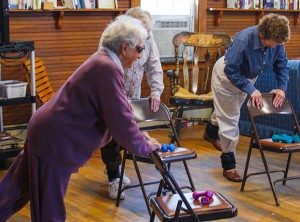
The population of older adults in the United States is increasing steadily, and in northern New England, the increase significantly outpaces other regions’ growth. In the 20th century, the “three-legged stool” of pensions, savings, and Social Security helped to sustain older adults after retirement. In the latter part of the 20th century—and certainly today—pensions have become a rare benefit and studies show that as adults move toward retirement, most have saved $50,000 or less. At the same time, the costs of long-term care have become almost prohibitive, approaching $100,000 annually for nursing home care. In New Hampshire, at least 50% of elders who require nursing home care end up on Medicaid. Public funding for many supportive programs for older adults has been cut at both state and federal levels. We cannot assume that families are readily available to take care of their elders. In New England, affiliation with faith communities is lower than in other regions of the country.
Grafton County has one of the highest proportions of older adults in a state and region that are experiencing dramatic growth of the older population. One in three individuals in Grafton County will be over age 60 by 2030. A housing study conducted by the Upper Valley Lake Sunapee Regional Planning Commission projects that 48% of heads of households in the immediate region will be 65 or over by 2030. In addition, Grafton County has one of the highest levels of older adults living on low to moderate incomes. Data from the National Council on Aging indicate that 41.3% of Grafton County’s older adults live on incomes of $2,000 per month or less.
Public Health Council Goals for Helping Older Adults Stay Strong and Independent
- Increase access to preventive care (e.g., dental care, cancer and other health screening, vaccines).
- Reduce older adult falls.
- Increase supports for aging in community, including social and emotional supports, recreation, transportation assistance, and more.
Key Partners Working on These Goals
Aging Resource Center at Dartmouth
The Dartmouth-Hitchcock Aging Resource Center provides older adults, families, and community members with information, education, and support to help them live healthier and more informed lives.
Grafton County Senior Citizens Council
With eight senior centers in Grafton County, GCSCC offers weekday meals, activities, gift shops, exercise classes, computer labs and so much more.
Senior Solutions is one of five Area Agencies on Aging in Vermont.
United Valley Interfaith Project
Aging with Dignity Campaign
The “Useful Tools for Aging with Dignity” curriculum was developed by UVIP’s Aging in Community Team – “a program developed BY seniors FOR seniors”. It is designed to provide tools for seniors to organize their affairs, plan for medical issues, and stay connected to their communities.
FEATURED PARTNER: Upper Valley Community Nursing Project
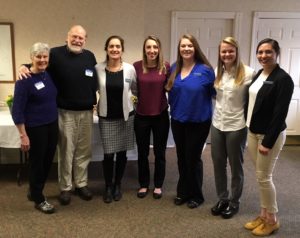
Laurie Harding and Bob Rufsvold (left), Co-Directors of the UVCNP, with Professor Shari Goldberg and Colby-Sawyer College Senior Nursing Students in April 2018.
The Upper Valley Community Nursing Project helps elders receive continuity of care and remain independent—at home and in their community.
Their goal is to add a health professional to the informal network of volunteers already providing care for elders, and to facilitate the placement of a nurse in a community to address non-acute needs of elders at home.
Since early in 2017, the Public Health Council has partnered with the Upper Valley Community Nursing Project by serving as their fiscal sponsor and helping to promote their work. To learn more, visit the UVCNP website.
Older Adult Programs and News
Aging in Community Quarterly Forum
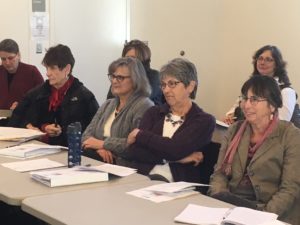
Aging in Community Forum attendees learn about United Valley Interfaith Project’s Tools for Aging with Dignity training, March 2017.
In communities across our region, people are coming together to provide support to friends and neighbors facing challenges with transportation, household chores, isolation, and other tasks of daily life. Each community provides its own blend of services and works in its own way. Together, these groups are building a critical local safety net for older adults who want to remain living in their own communities as they age.
The Public Health Council hosts quarterly meetings designed with and for these Aging in Community volunteer groups. These forums provide an opportunity for community groups to share their successes and challenges. They learn about helpful resources for training and developing services. They increase their knowledge of issues facing older adults, like fraud, depression, and services available through partner agencies. To learn more about community groups and the Aging in Community Quarterly Forum, contact Alice Ely.
Preventing Older Adult Falls
Since 2015, multiple partners around the Upper Valley have been offering more and better programs to reduce falls among older adults.
Education and Strength Building: Numerous senior centers, health centers, and recreation programs offer evidence-based falls prevention programs like Matter of Balance and Tai Ji Quan: Moving for Better Balance.
Screening: Numerous organizations and community nurses now offer fall screenings in convenient locations around the region, giving older adults valuable information about their risks and how to reduce their risks.
For an interactive map of screening, education, strength building programs, as well as stories about some of the falls prevention work ongoing in the region, look for the Falls Prevention Overview page at the Community Health Hub website.
How Do F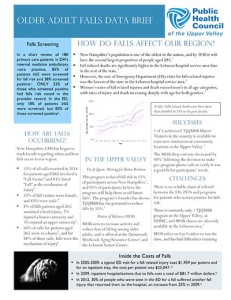 alls Affect our Region
alls Affect our Region
To better understand the impact of older adult falls in Grafton County, the Public Health Council prepared a data brief on the topic in 2015. The data laid the groundwork for later work to build more programs and resources in the region. This work was funded by the NH Division of Public Health Services. Click on image to view data brief.
